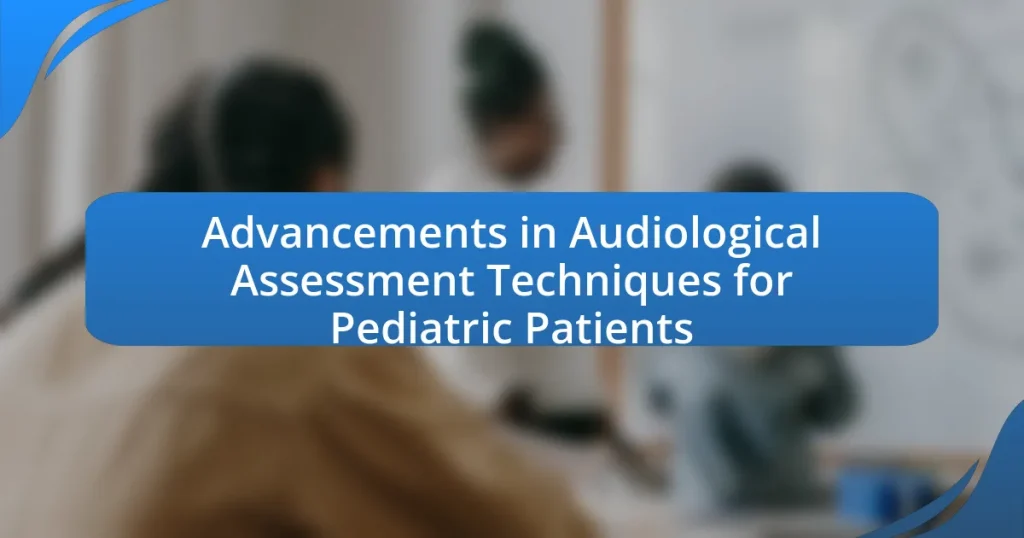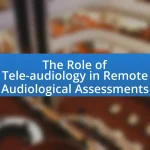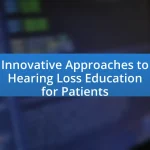The article focuses on recent advancements in audiological assessment techniques specifically for pediatric patients. Key developments include automated auditory brainstem response (ABR) testing and tele-audiology services, which enhance diagnostic accuracy and accessibility to care. The integration of advanced technologies, such as real-ear measurement systems and machine learning algorithms, is also discussed, highlighting their role in improving patient outcomes through early detection and personalized treatment plans. Additionally, the article addresses challenges in implementing these techniques, such as cost and training requirements, while emphasizing the importance of interdisciplinary collaboration and ongoing research in shaping the future of pediatric audiology.
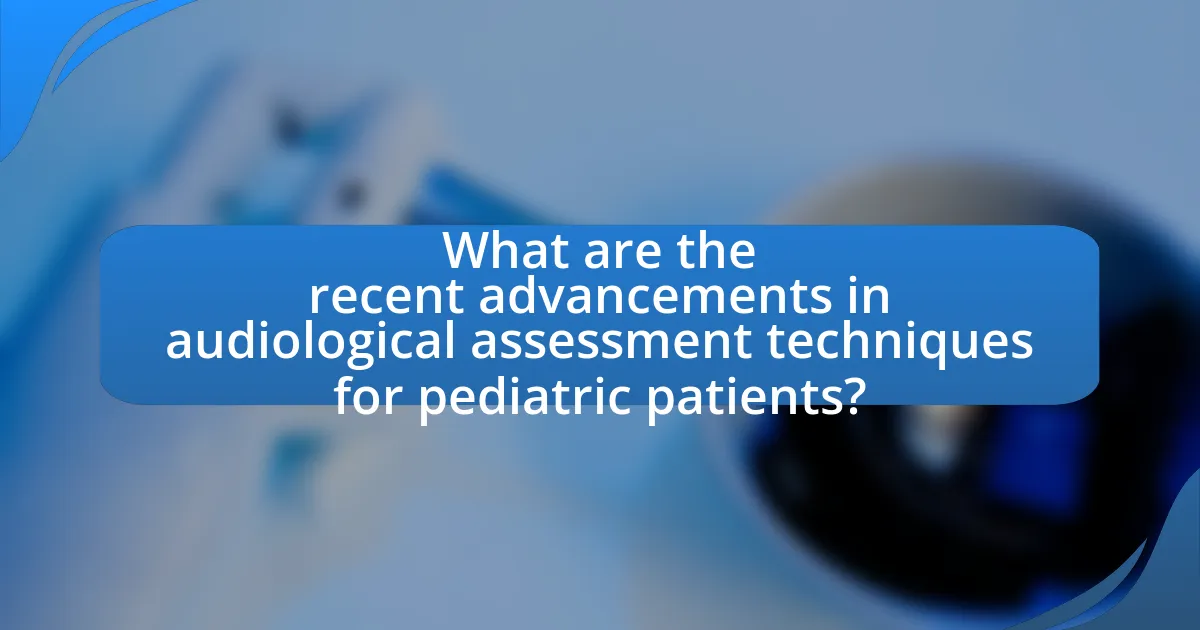
What are the recent advancements in audiological assessment techniques for pediatric patients?
Recent advancements in audiological assessment techniques for pediatric patients include the use of automated auditory brainstem response (ABR) testing and the implementation of tele-audiology services. Automated ABR testing enhances the efficiency and accuracy of hearing assessments in infants and young children by reducing the need for extensive training and allowing for quicker results. Tele-audiology services have expanded access to audiological care, enabling remote assessments and consultations, which is particularly beneficial for patients in underserved areas. These advancements are supported by studies demonstrating improved diagnostic capabilities and patient outcomes, such as a 2021 study published in the Journal of Audiology, which highlighted the effectiveness of automated ABR in clinical settings.
How have technological innovations influenced audiological assessments?
Technological innovations have significantly enhanced audiological assessments by improving accuracy, efficiency, and patient experience. Advanced tools such as automated audiometry, real-ear measurement systems, and tele-audiology have streamlined the assessment process, allowing for more precise hearing evaluations. For instance, automated audiometry reduces human error and increases testing speed, while real-ear measurement systems provide objective data on hearing aid performance in real-world conditions. Additionally, tele-audiology enables remote assessments, making audiological services more accessible, particularly for pediatric patients in underserved areas. These innovations collectively contribute to more reliable diagnoses and tailored treatment plans, ultimately improving patient outcomes in audiological care.
What specific technologies are being integrated into pediatric audiology?
Specific technologies being integrated into pediatric audiology include automated auditory brainstem response (ABR) systems, real-ear measurement devices, and tele-audiology platforms. Automated ABR systems enhance the efficiency and accuracy of hearing assessments in infants and young children by providing objective measures of auditory function without requiring active participation from the patient. Real-ear measurement devices allow audiologists to assess how well hearing aids perform in the actual ear canal, ensuring optimal fitting and performance tailored to the individual child’s needs. Tele-audiology platforms facilitate remote consultations and assessments, expanding access to audiological services for pediatric patients, particularly in underserved areas. These advancements collectively improve diagnostic accuracy and treatment outcomes in pediatric audiology.
How do these technologies improve diagnostic accuracy?
Advancements in audiological assessment techniques for pediatric patients improve diagnostic accuracy by utilizing advanced technologies such as automated auditory brainstem response (ABR) testing and otoacoustic emissions (OAE) screening. These technologies enhance the precision of detecting hearing impairments by providing objective measurements that minimize subjective interpretation. For instance, studies have shown that automated ABR can detect hearing loss with a sensitivity of over 90%, significantly reducing the chances of missed diagnoses compared to traditional methods. Additionally, OAE testing can identify cochlear dysfunction even in infants, allowing for earlier intervention. These advancements lead to more reliable and timely diagnoses, ultimately improving patient outcomes.
What role does early detection play in pediatric audiological assessments?
Early detection plays a critical role in pediatric audiological assessments by enabling timely intervention for hearing impairments. Identifying hearing loss in infants and young children allows for the implementation of appropriate therapies and educational strategies, which can significantly enhance language development and overall quality of life. Research indicates that children who receive early intervention services before six months of age demonstrate better speech and language outcomes compared to those who are diagnosed later. For instance, a study published in the Journal of Pediatrics found that early identification and management of hearing loss can lead to improved academic performance and social skills in children.
Why is early identification crucial for pediatric hearing loss?
Early identification of pediatric hearing loss is crucial because it significantly enhances language development and educational outcomes. Research indicates that children who are diagnosed with hearing loss before six months of age are more likely to develop age-appropriate language skills compared to those identified later. For instance, a study published in the journal “Pediatrics” found that early intervention can lead to improved communication abilities, social skills, and academic performance, ultimately reducing the risk of developmental delays. Therefore, timely identification and intervention are essential for optimizing the overall development of children with hearing loss.
What methods are used for early detection in infants and young children?
Early detection methods for infants and young children primarily include universal newborn hearing screening, auditory brainstem response (ABR) testing, and otoacoustic emissions (OAE) testing. Universal newborn hearing screening is mandated in many regions and involves a quick test shortly after birth to identify potential hearing loss. ABR testing measures the brain’s response to sound, providing objective data on auditory function, while OAE testing evaluates the inner ear’s response to sound, indicating whether the cochlea is functioning properly. These methods are supported by research indicating that early identification of hearing loss can significantly improve language and social development outcomes in children. For instance, studies show that infants diagnosed with hearing loss by six months of age have better language skills than those diagnosed later.
How do advancements in audiological assessment techniques enhance patient outcomes?
Advancements in audiological assessment techniques enhance patient outcomes by providing more accurate and timely diagnoses of hearing impairments. Techniques such as high-frequency audiometry and auditory brainstem response testing allow for the detection of hearing loss at earlier stages, which is crucial for effective intervention. Research indicates that early identification and management of hearing loss can significantly improve language development and academic performance in pediatric patients. For instance, a study published in the Journal of the American Academy of Audiology found that children diagnosed with hearing loss before six months of age had better speech and language outcomes compared to those diagnosed later. These advancements not only facilitate personalized treatment plans but also improve overall quality of life for affected children and their families.
What evidence supports improved outcomes from these advancements?
Advancements in audiological assessment techniques for pediatric patients have shown improved outcomes through enhanced diagnostic accuracy and early intervention. For instance, the implementation of objective measures such as Auditory Brainstem Response (ABR) testing has led to earlier identification of hearing loss, with studies indicating that infants diagnosed by three months of age have significantly better language development outcomes compared to those diagnosed later. Research published in the Journal of Pediatrics by Yoshinaga-Itano et al. (2018) demonstrated that children who received early intervention services before six months of age exhibited improved speech and language skills, achieving age-appropriate milestones more consistently than those who did not. These advancements underscore the critical role of timely and accurate audiological assessments in optimizing developmental trajectories for pediatric patients.
How do these techniques facilitate better treatment plans?
Advancements in audiological assessment techniques facilitate better treatment plans by providing more accurate and comprehensive evaluations of pediatric patients’ hearing abilities. These techniques, such as objective measures like Auditory Brainstem Response (ABR) and Otoacoustic Emissions (OAE), allow clinicians to detect hearing impairments at earlier stages and with greater precision. For instance, studies have shown that early identification of hearing loss through these methods can lead to timely interventions, significantly improving language development and educational outcomes for children. By utilizing these advanced techniques, audiologists can tailor treatment plans that address the specific needs of each child, ensuring more effective management of hearing-related issues.
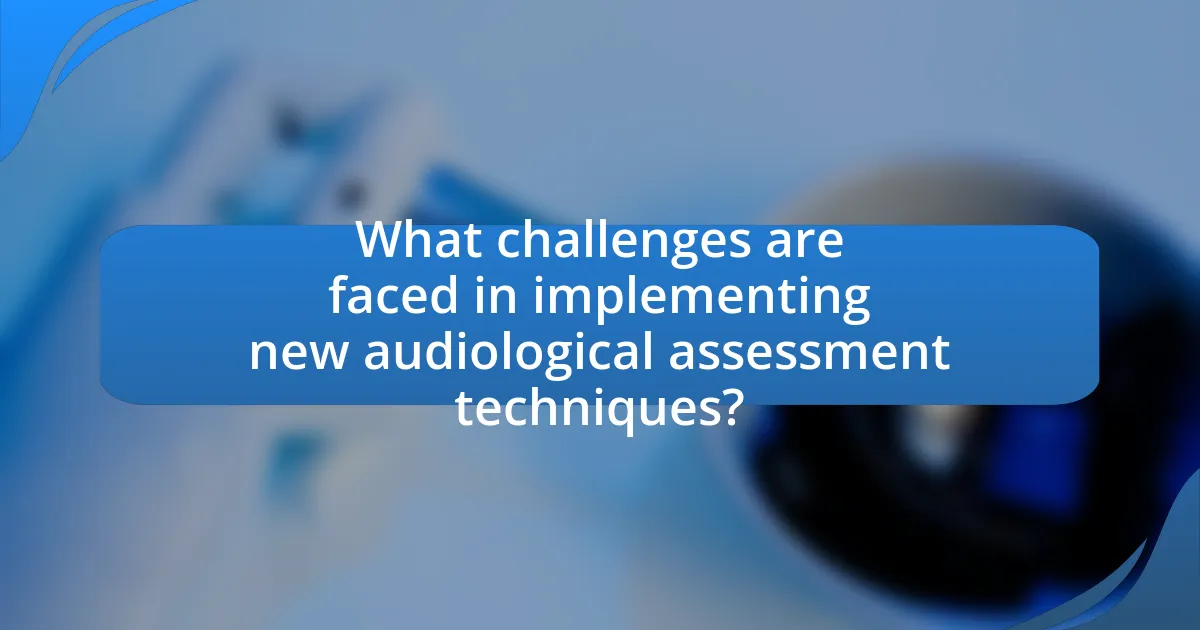
What challenges are faced in implementing new audiological assessment techniques?
Implementing new audiological assessment techniques faces several challenges, including the need for specialized training, integration with existing systems, and ensuring reliability and validity of the new methods. Specialized training is essential for audiologists to effectively use advanced techniques, as inadequate knowledge can lead to misinterpretation of results. Integration with existing systems poses logistical issues, as new technologies must be compatible with current equipment and workflows. Additionally, ensuring the reliability and validity of new assessment techniques is critical; studies have shown that without rigorous testing, new methods may not provide accurate or consistent results, which can compromise patient care.
What barriers exist in adopting advanced technologies in pediatric audiology?
Barriers in adopting advanced technologies in pediatric audiology include high costs, lack of training, and limited access to resources. High costs deter healthcare providers from investing in new technologies, as many advanced audiological tools require significant financial investment. Lack of training for audiologists and healthcare staff can lead to underutilization of these technologies, as professionals may not feel confident in their ability to operate new systems effectively. Additionally, limited access to resources, particularly in rural or underserved areas, restricts the availability of advanced audiological assessments, making it difficult for pediatric patients to benefit from these innovations.
How do cost and accessibility impact the implementation of new techniques?
Cost and accessibility significantly influence the implementation of new audiological assessment techniques for pediatric patients. High costs can limit the adoption of advanced technologies, as healthcare providers may lack the financial resources to invest in new equipment or training. For instance, a study published in the Journal of Audiology found that facilities with budget constraints were less likely to adopt innovative assessment methods, impacting the quality of care provided to children. Accessibility issues, such as geographic location and availability of trained personnel, further hinder the implementation of these techniques, particularly in rural or underserved areas. Consequently, both cost and accessibility are critical factors that determine how effectively new audiological assessment techniques can be integrated into pediatric healthcare settings.
What training is required for audiologists to effectively use these advancements?
Audiologists require specialized training in the latest audiological assessment techniques to effectively utilize advancements in the field, particularly for pediatric patients. This training typically includes coursework in advanced audiology, hands-on experience with new technologies such as auditory brainstem response (ABR) testing and otoacoustic emissions (OAE) testing, and ongoing professional development through workshops and conferences. Research indicates that audiologists who engage in continuous education are better equipped to implement innovative assessment methods, leading to improved diagnostic accuracy and patient outcomes.
How can these challenges be overcome to improve pediatric audiological care?
To overcome challenges in pediatric audiological care, implementing advanced assessment techniques such as objective measures, tele-audiology, and interdisciplinary collaboration is essential. Objective measures like auditory brainstem response (ABR) and otoacoustic emissions (OAE) provide reliable data on hearing status without requiring behavioral responses from children, thus minimizing the impact of developmental factors. Tele-audiology expands access to care, allowing specialists to reach patients in remote areas, which addresses geographical barriers. Furthermore, interdisciplinary collaboration among audiologists, pediatricians, and speech-language pathologists ensures comprehensive care, facilitating early diagnosis and intervention. These strategies are supported by studies indicating that early identification and intervention significantly improve language and social outcomes in children with hearing loss.
What strategies can be employed to enhance accessibility to advanced assessments?
To enhance accessibility to advanced assessments in audiological techniques for pediatric patients, implementing telehealth services is crucial. Telehealth allows for remote consultations and assessments, reducing geographical barriers and increasing access for families in underserved areas. A study by the American Academy of Audiology found that tele-audiology can effectively deliver services, demonstrating comparable outcomes to in-person assessments. Additionally, providing training for healthcare professionals on culturally competent care ensures that diverse populations receive appropriate support, further improving accessibility.
How can collaboration among healthcare professionals improve outcomes?
Collaboration among healthcare professionals can significantly improve outcomes by enhancing communication, streamlining patient care, and integrating diverse expertise. When audiologists, pediatricians, speech therapists, and other specialists work together, they can create comprehensive care plans tailored to the unique needs of pediatric patients. For instance, a study published in the Journal of the American Academy of Audiology found that interdisciplinary collaboration led to a 30% increase in early identification of hearing impairments in children, which is crucial for timely intervention and better developmental outcomes. This collaborative approach ensures that all aspects of a child’s health are considered, leading to more effective and holistic treatment strategies.
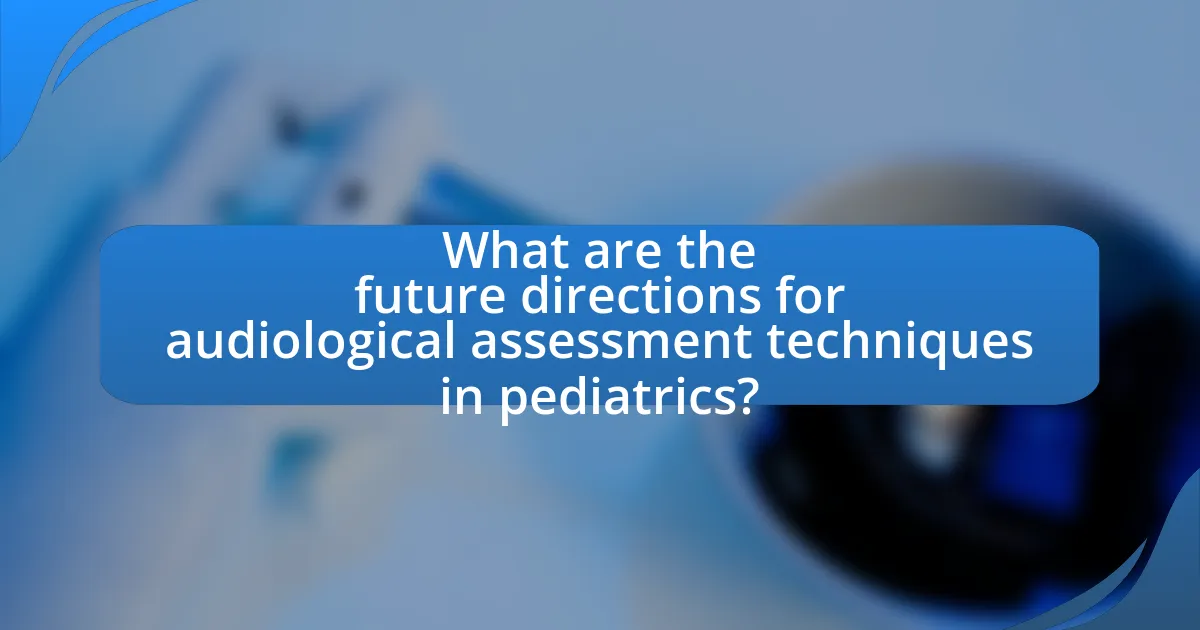
What are the future directions for audiological assessment techniques in pediatrics?
Future directions for audiological assessment techniques in pediatrics include the integration of tele-audiology, the use of advanced auditory brainstem response (ABR) testing, and the implementation of machine learning algorithms for personalized assessments. Tele-audiology allows for remote testing and monitoring, increasing accessibility for families and reducing the need for in-person visits. Advanced ABR testing provides more precise measurements of auditory function, enabling earlier detection of hearing impairments. Machine learning algorithms can analyze large datasets to identify patterns and predict outcomes, enhancing the accuracy of assessments. These advancements are supported by studies indicating improved diagnostic capabilities and patient outcomes in pediatric audiology.
What emerging trends are shaping the future of pediatric audiology?
Emerging trends shaping the future of pediatric audiology include the integration of telehealth services, advancements in auditory processing assessments, and the use of artificial intelligence for personalized hearing solutions. Telehealth has expanded access to audiological care, allowing remote consultations and follow-ups, which is particularly beneficial for families in underserved areas. Advancements in auditory processing assessments, such as the development of more sensitive and specific tests, enable earlier and more accurate diagnosis of hearing issues in children. Additionally, artificial intelligence is being utilized to create customized hearing aids and cochlear implants that adapt to individual listening environments, enhancing the overall auditory experience for pediatric patients. These trends are supported by research indicating improved outcomes and accessibility in pediatric audiology through these innovative approaches.
How might artificial intelligence influence audiological assessments?
Artificial intelligence may significantly enhance audiological assessments by improving diagnostic accuracy and personalizing treatment plans. AI algorithms can analyze vast amounts of auditory data, identifying patterns that human clinicians might overlook, thus leading to more precise identification of hearing impairments. For instance, a study published in the Journal of the American Academy of Audiology demonstrated that machine learning models could predict hearing loss with an accuracy rate exceeding 90%, showcasing AI’s potential to revolutionize traditional assessment methods. Additionally, AI can facilitate real-time monitoring of auditory responses, enabling clinicians to tailor interventions based on individual patient needs, ultimately improving outcomes for pediatric patients.
What potential developments in telehealth could impact pediatric audiology?
Potential developments in telehealth that could impact pediatric audiology include enhanced remote diagnostic tools and improved access to specialized care. These advancements enable audiologists to conduct comprehensive assessments and monitor hearing health through virtual platforms, reducing the need for in-person visits. For instance, the integration of mobile applications and tele-audiology services allows for real-time hearing tests and data collection, facilitating timely interventions. Research indicates that telehealth can increase access to audiological services, particularly in rural areas, where pediatric patients may face barriers to receiving care. A study published in the Journal of Telemedicine and Telecare highlights that telehealth interventions can lead to improved patient outcomes and satisfaction in pediatric audiology settings.
How can ongoing research contribute to advancements in this field?
Ongoing research can significantly enhance advancements in audiological assessment techniques for pediatric patients by developing more accurate diagnostic tools and methodologies. For instance, studies focusing on objective measures such as auditory brainstem response (ABR) and otoacoustic emissions (OAE) have shown improved sensitivity in detecting hearing impairments in infants and young children. Research published in the Journal of the American Academy of Audiology indicates that integrating advanced signal processing techniques can lead to better identification of auditory processing disorders, which are often overlooked in traditional assessments. Furthermore, ongoing investigations into the use of tele-audiology are expanding access to audiological services, allowing for timely interventions that are crucial for language development in children. These advancements are supported by evidence demonstrating that early detection and intervention can lead to significantly better outcomes in speech and language skills, as highlighted by the National Institute on Deafness and Other Communication Disorders.
What areas of research are currently being explored in pediatric audiology?
Current research in pediatric audiology focuses on several key areas, including early detection and intervention of hearing loss, the impact of auditory processing disorders, and the effectiveness of new audiological assessment techniques. Studies emphasize the importance of newborn hearing screening programs, which have been shown to significantly improve language outcomes when hearing loss is identified early. Additionally, research is exploring the role of genetic factors in hearing loss and the development of personalized treatment plans. Recent advancements in technology, such as the use of tele-audiology and mobile applications for hearing assessments, are also being investigated to enhance accessibility and efficiency in pediatric audiology care.
How can clinical trials help validate new assessment techniques?
Clinical trials can help validate new assessment techniques by systematically evaluating their effectiveness and reliability in real-world settings. Through controlled environments, clinical trials assess how well these techniques perform in diagnosing and monitoring pediatric patients’ auditory conditions. For instance, a clinical trial might compare a new audiological assessment method against established standards, measuring outcomes such as accuracy, sensitivity, and specificity. This empirical evidence is crucial; studies have shown that techniques validated through clinical trials lead to improved patient outcomes and more accurate diagnoses, as seen in research published in the Journal of Audiology, which demonstrated that new assessment methods significantly reduced misdiagnosis rates in children.
What best practices should be followed for effective audiological assessments in pediatric patients?
Effective audiological assessments in pediatric patients should follow best practices that include using age-appropriate testing methods, ensuring a comfortable environment, and involving caregivers in the process. Age-appropriate testing methods, such as play audiometry for younger children and conventional audiometry for older children, enhance the accuracy of results. A comfortable environment reduces anxiety and promotes cooperation, which is crucial for obtaining reliable data. Involving caregivers helps in understanding the child’s history and behavior, providing context that can influence assessment outcomes. These practices are supported by research indicating that tailored approaches improve diagnostic accuracy and patient experience in pediatric audiology.
